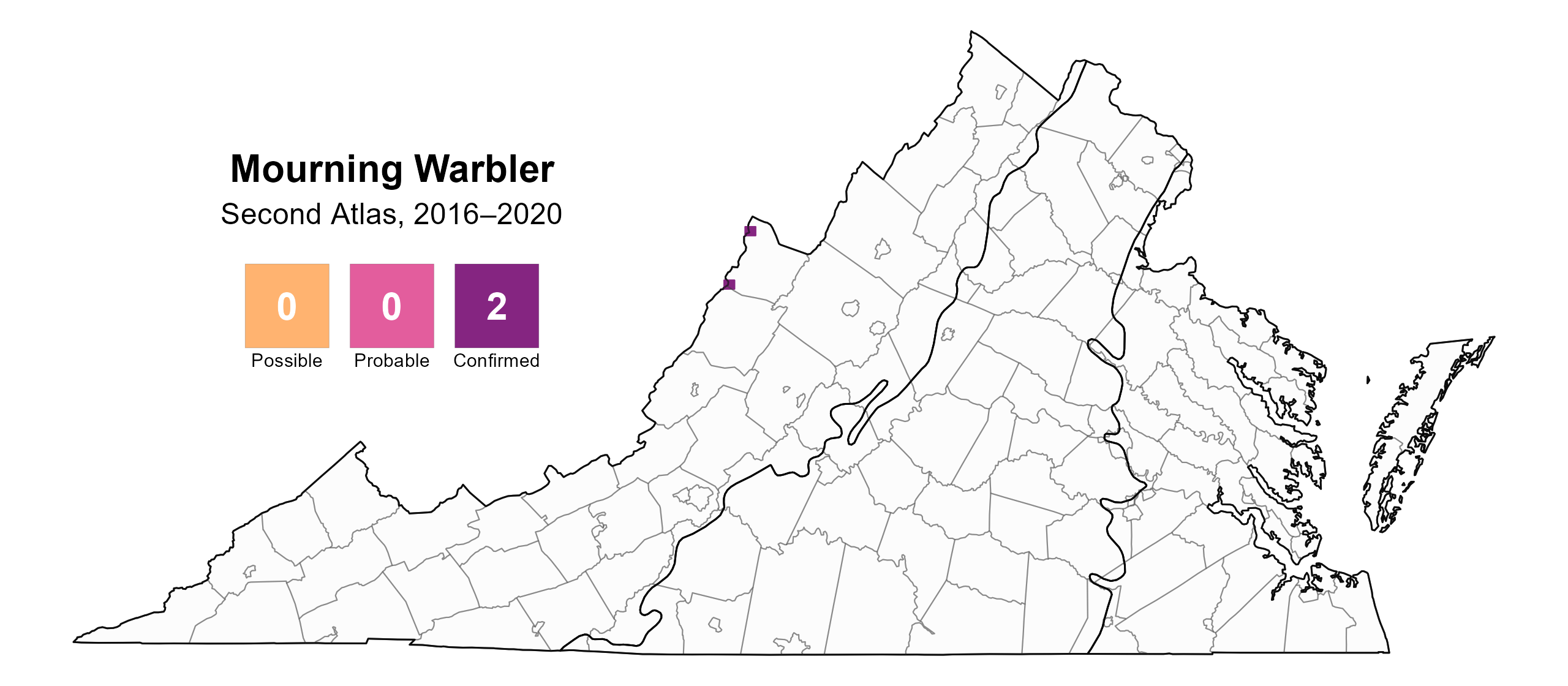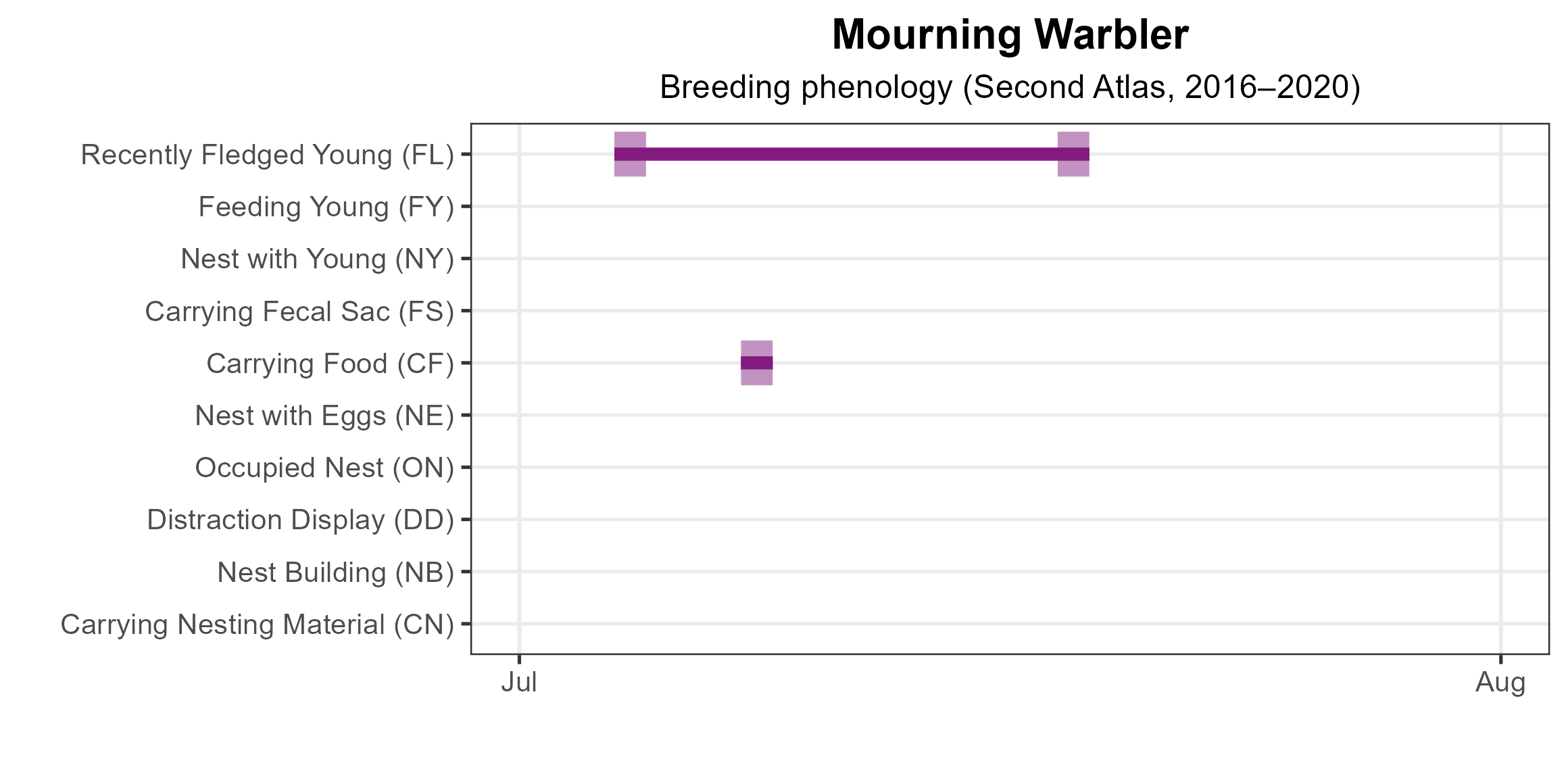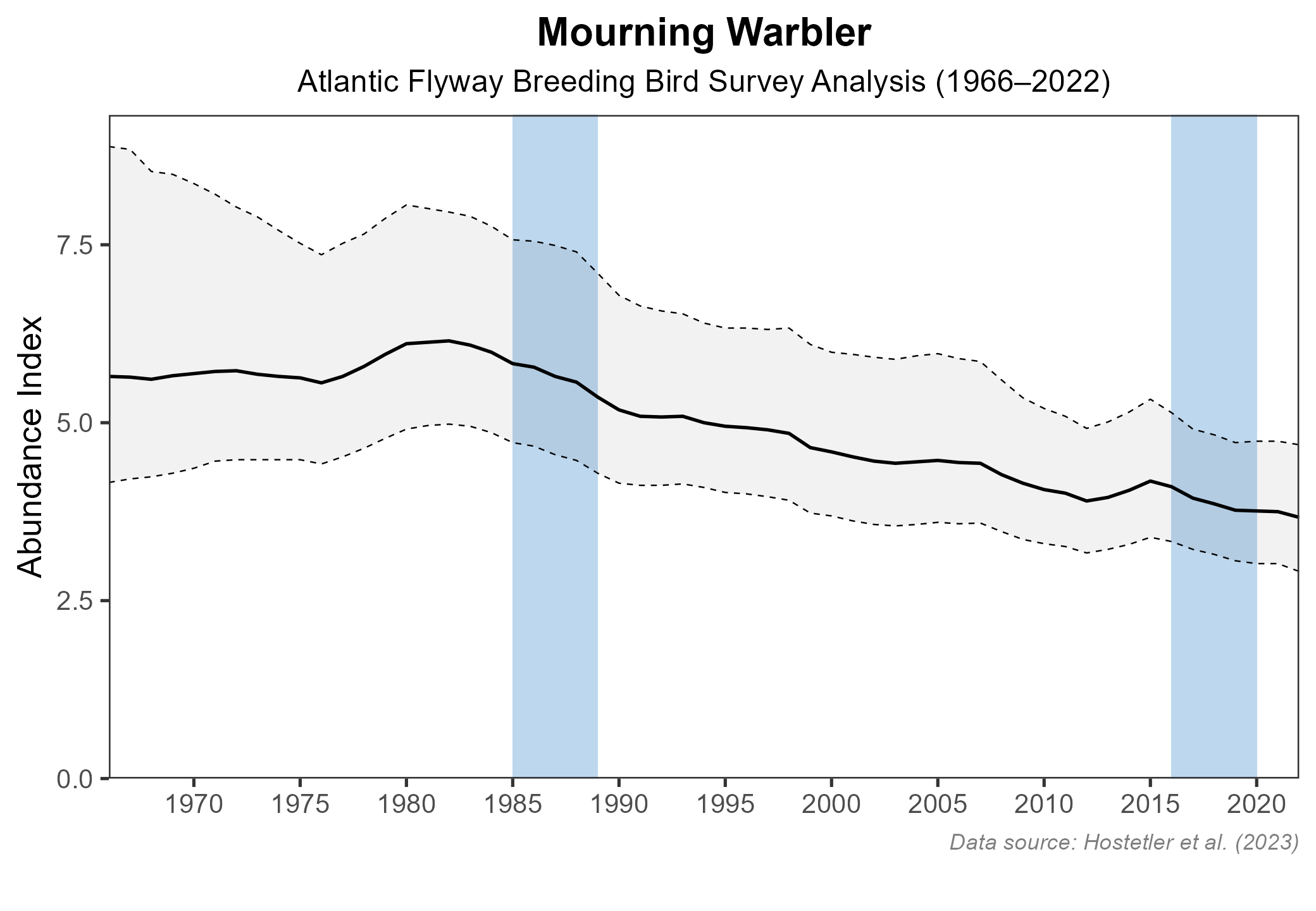Introduction
Should you manage to get eyes on it, a Mourning Warbler in Virginia is always a treat. This robust, skulking warbler is rare during migration everywhere in the state (Rottenborn and Brinkley 2007). Mourning Warblers were first noted as probable breeders in Virginia in the 1930s (Brooks 1935, 1937).
The Mourning Warbler’s primary breeding range includes New England, the Upper Midwest, and southern Canada. However, there is a small, isolated population that breeds in high-elevation coniferous forests of West Virginia and Virginia. Mourning Warblers are “disturbance dependent,” and breeding sites typically consist of dense thickets of raspberry or blackberry (Rubus spp.), sometimes in powerline cuts (Stevens 1965; Pitocchelli 2020).
Breeding Distribution
Very limited breeding data prevented the development of occupancy models for the Mourning Warbler. For more information on its distribution, see the Breeding Evidence section.
Breeding Evidence
Mourning Warblers were confirmed breeders in only two blocks during the Second Atlas. In northern Highland County, they were documented as confirmed breeders along Sapling Ridge in the Laurel Fork Wilderness Area along the West Virginia border. In southwestern Highland, they were confirmed on the Virginia side of Paddy Knob, directly on the border with Bath County (Figure 1). Breeding locations were all above 3,500 ft (1,066 m) in elevation.
During the First Atlas, this species was confirmed breeding in Augusta County at Elliot Knob and recorded as a probable breeder in western Highland County at Paddy Knob (Figure 2). Immediately prior to the First Atlas, the species was also known to breed in Bath, Galax, and Madison/Page counties (Hall 1976, 1977).
As a disturbance-dependent species, turnover in breeding sites is inevitable. The species was formerly more abundant along Laurel Fork in Highland County (Stevens 1965), but ecological succession in this area reduced available habitat over time (Rottenborn and Brinkley 2007).
The limited number of records presents an incomplete picture of the species’ breeding phenology. In Highland County, breeding was confirmed through observations of recently fledged young (July 4 – July 18) and adults carrying food (July 8) (Figure 3). For more general information on the breeding habits of this species, please refer to All About Birds.

Figure 1: Mourning Warbler breeding observations from the Second Atlas (2016–2020). The colored boxes illustrate Atlas blocks (approximately 10 mi2 [26 km2] survey units) where the species was detected. The colors show the highest breeding category recorded in a block. The numbers within the colors in the legend correspond to the number of blocks with that breeding evidence category.

Figure 2: Mourning Warbler breeding observations from the First Atlas (1985–1989). The colored boxes illustrate Atlas blocks (approximately 10 mi2 [26 km2] survey units) where the species was detected. The colors show the highest breeding category recorded in a block. The numbers within the colors in the legend correspond to the number of blocks with that breeding evidence category.

Figure 3: Mourning Warbler phenology: confirmed breeding codes. This graph shows a timeline of confirmed breeding behaviors. Tick marks represent individual observations of the behavior.
Population Status
Limited detections during the point count surveys prevented the development of an abundance model for the Mourning Warbler. Similarly, the North American Breeding Bird Survey (BBS) data are insufficient for determining a reliable population trend estimate for the Mourning Warble in Virginia; however, the BBS trend at the Atlantic Flyway scale shows that its population has experienced a significant decrease of 0.77% per year from 1966–2022 (Hostetler et al. 2023; Figure 4). Between Atlases, BBS data at the same scale showed a significant decline of 1.23% per year from 1987–2018.

Figure 4: Mourning Warbler population trend for the Atlantic Flyway as estimated by the North American Breeding Bird Survey. The vertical axis shows species abundance; the horizontal axis shows the year. The solid line indicates the estimated population trend; there is a 97.5% probability that the true population trend falls between the dashed lines. The shaded bars indicate the First and Second Atlas periods.
Conservation
Although they rarely breed in Virginia, Mourning Warblers appear to be declining throughout part of their range based on BBS data. Efforts on managed forested lands that promote different age-class stands and reduce canopy cover will also benefit this species (Pitocchelli 2020). Additionally, Mourning Warblers are “disturbance dependent” and tend to nest in regenerating coniferous forest that has formed dense thickets (Pitocchelli 2020). Interestingly, this makes the Mourning Warbler relatively resilient to a variety of forestry management practices and other activities that alter forested landscapes (Pitocchelli 2020).
Interactive Map
The interactive map contains up to six Atlas layers (probability of occurrence for the First and Second Atlases, change in probability of occurrence between Atlases, breeding evidence for the First and Second Atlases, and abundance for the Second Atlas) that can be viewed one at a time. To view an Atlas map layer, mouse over the layer box in the upper left. County lines and physiographic regional boundaries (Mountains and Valleys, Piedmont, and Coastal Plain) can be turned on and off by checking or unchecking the box below the layer box. Within the map window, users can hover on a block to see its value for each layer and pan and zoom to see roads, towns, and other features of interest that are visible beneath a selected layer.
View Interactive Map in Full Screen
References
Brooks, M. (1935). Some notes on the birds of Highland County. The Raven 6:1–3.
Brooks, M. (1937). Mourning Warbler in Highland County. The Raven 8:47.
Hall, G. A. (1976). Regional reports, nesting season, June 1 to July 31, 1976. Appalachian Region. American Birds 30:954–957.
Hall, G. A. (1977). Regional reports, nesting season, June 1 to July 31, 1977. Appalachian Region. American Birds 31:1138–1142.
Pitocchelli, J. (2020). Mourning Warbler (Geothlypis philadelphia), version 1.0. In Birds of the World (P. G. Rodewald, Editor). Cornell Lab of Ornithology, Ithaca, NY, USA. https://doi.org/10.2173/bow.mouwar.01.
Stevens, C. S. (1965). The Mourning Warbler and other summer birds of Highland County, Virginia. The Raven 36:3–7.




